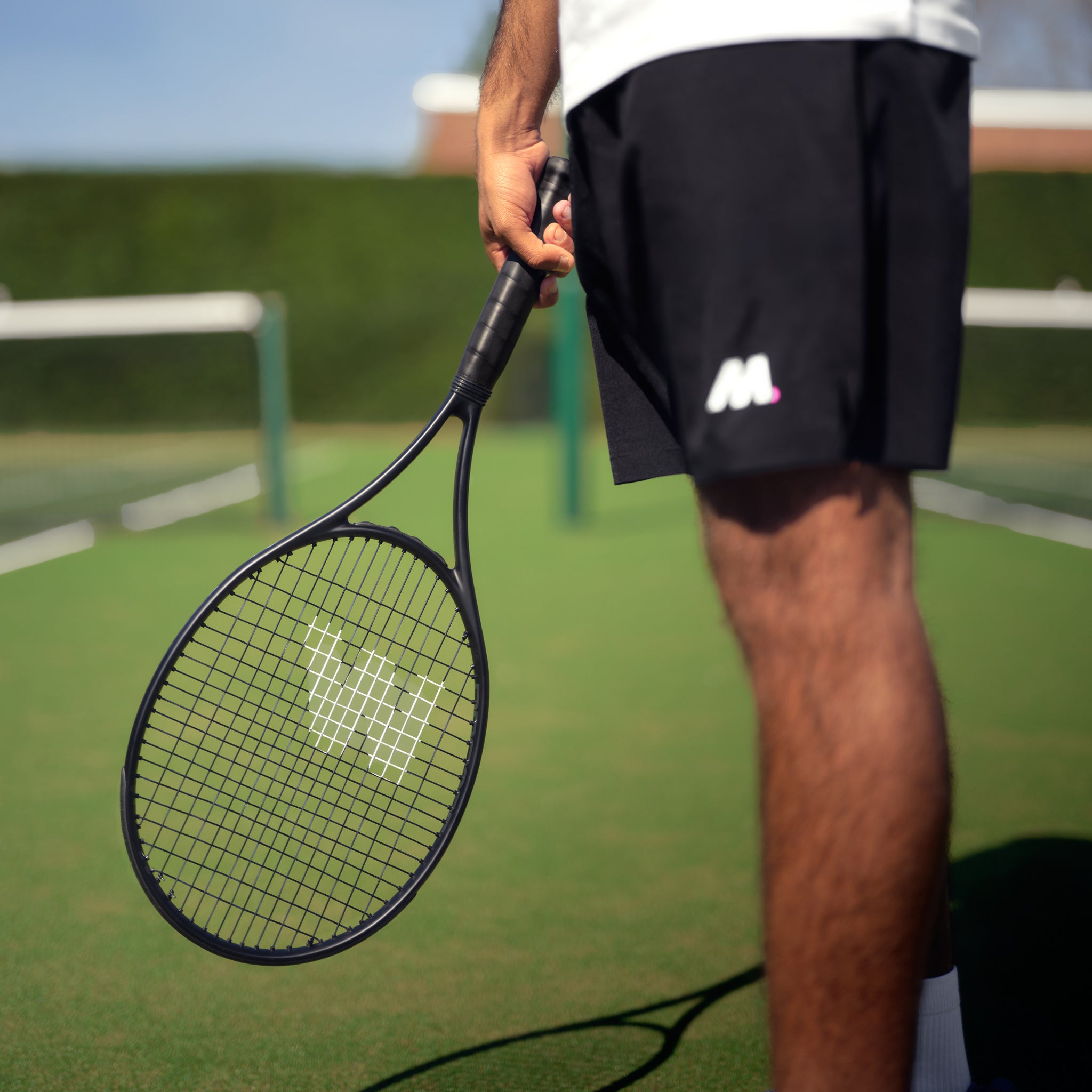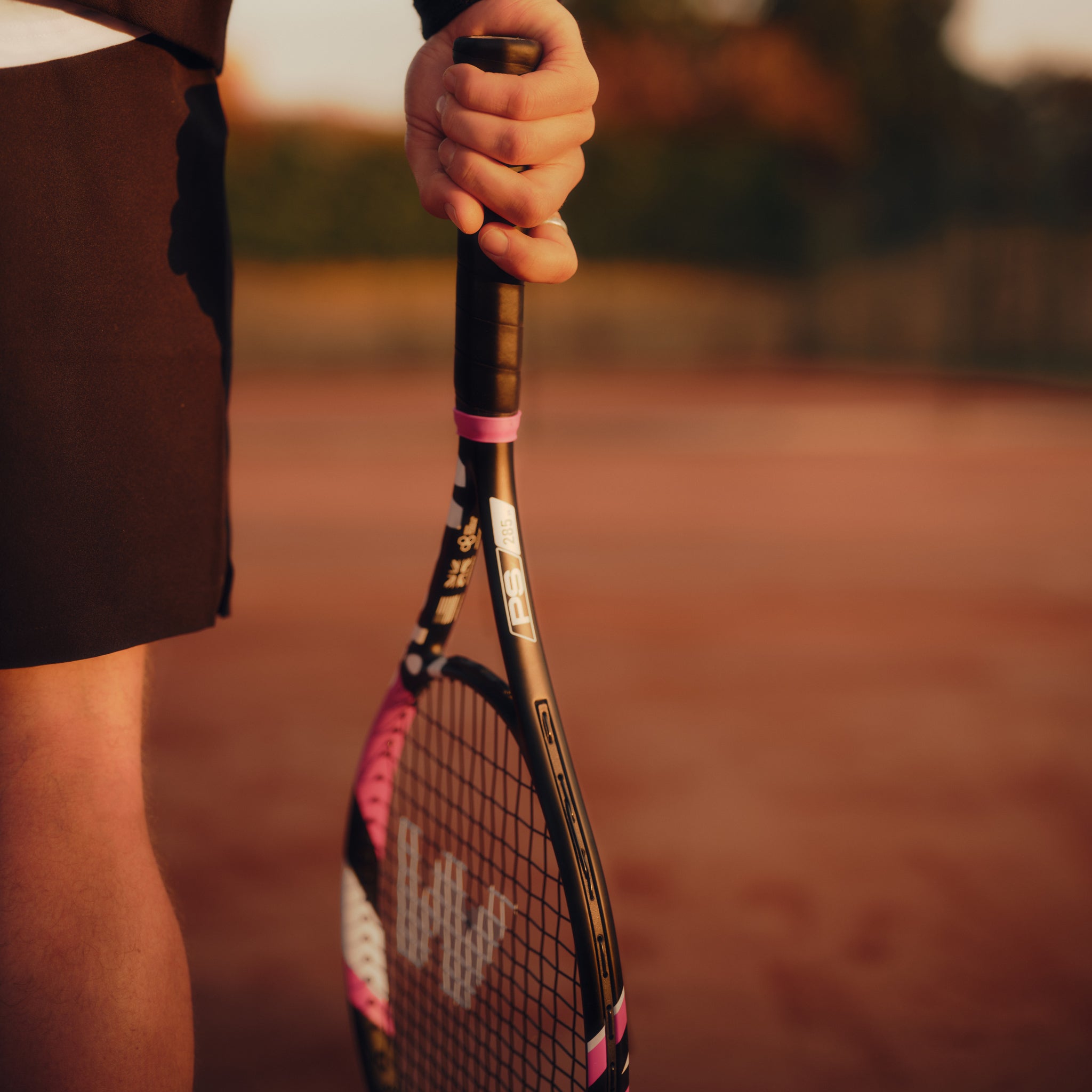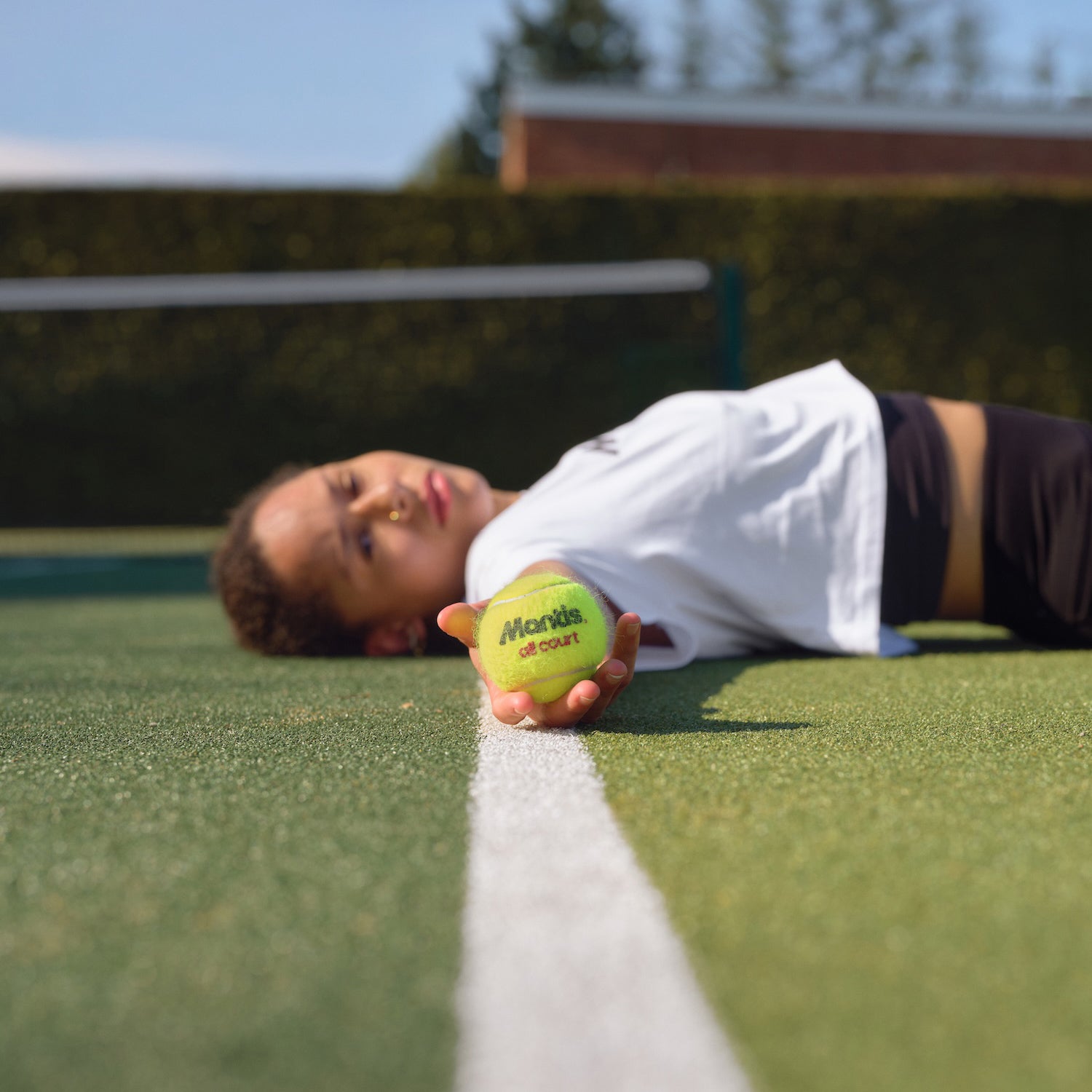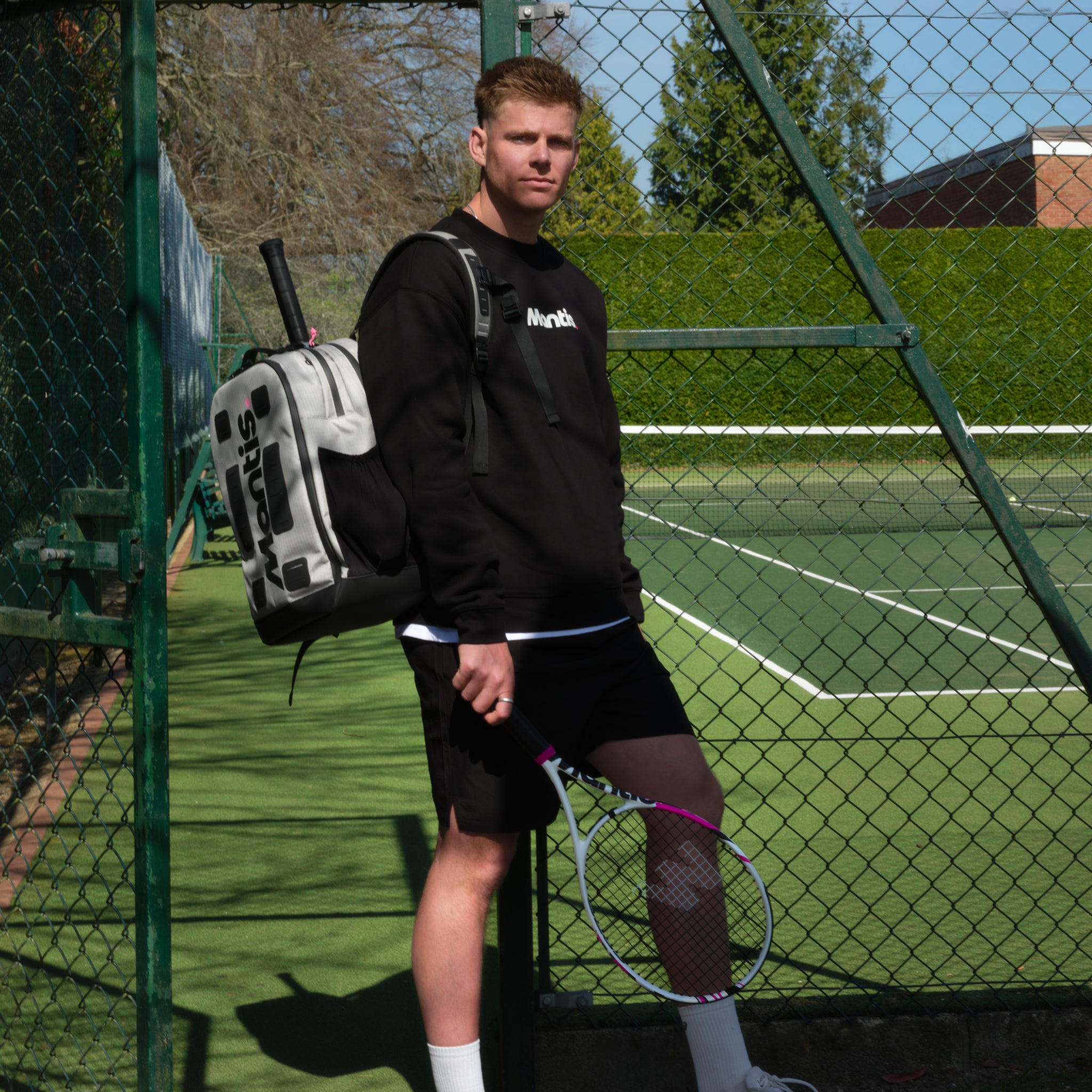
When we talk about "tennis fitness," we're not just talking about going for a run or lifting some weights. It’s a specialised approach designed to build the exact physical attributes you need on the court. Think explosive power for serves, lightning-fast direction changes to chase down a drop shot, and the sheer stamina to outlast your opponent in a third-set tiebreak. At Mantis, we believe that understanding how to choose a tennis racket is just the first step in optimising your game; a dedicated fitness regimen is the next.
A well-structured programme connects every gym session directly to your game, making you a stronger, faster, and more resilient player.
Why Tennis Fitness Is Your Secret Weapon
Talent and technique will only get you so far. At Mantis, we've seen time and again that a dedicated tennis fitness programme is what truly separates the good players from the great ones. It's about building a body that's been specifically primed for the unique demands of tennis.
Getting to grips with the core pillars of athletic performance is the first real step towards unlocking your potential. After all, your body is your most important piece of equipment. For more on that, it's worth learning how to choose a tennis racket that plays to your physical strengths.
The Four Pillars of a tennis fitness program to improve On-Court Performance
A truly effective fitness plan is built on four pillars. If one is weak, you can bet a smart opponent will find a way to exploit it.
-
Strength and Power: This is where your big shots come from. A booming serve isn't just an arm motion; it's a kinetic chain that starts from your legs and explodes up through your hips and core. Functional strength training is how you build that explosive force and make it repeatable.
-
Agility and Footwork: Tennis is all about controlled chaos—sprinting, sliding, and stopping on a sixpence. Elite agility means you get to more balls, set up for your shots earlier, and recover your court position in a flash.
-
Endurance and Stamina: We’ve all been in those gruelling three-setters that test your will as much as your body. Court-specific endurance ensures your performance doesn't drop off a cliff after the first hour, helping you cut down on those cheap, fatigue-driven errors.
-
Flexibility and Mobility: A great range of motion is your best defence against injury. It also directly impacts your technique. Think about it: good hip and shoulder flexibility allows for more effortless power on your groundstrokes and a much smoother service action.
By working on each of these areas, you're doing more than just getting fit. You're building a more dynamic, durable, and dominant version of yourself on the court. It's like engineering a high-performance machine where every component works in perfect sync.
Ultimately, committing to a proper fitness plan is an investment in your game and your long-term health in the sport. It closes the gap between knowing the right shot to hit and having the physical ability to execute it flawlessly, especially under pressure. As you get into the specific drills, remember you’re not just building muscle; you’re laying the foundation for your next win. The experts at RacketBusiness.com also share some brilliant insights for anyone looking to take their game to the next level.
Your Pre-Match Dynamic Warm-Up Routine
Hitting the court cold is a recipe for a slow start and, worse, a potential injury. We can't stress this enough: a dynamic warm-up isn't just a pre-match ritual; it's a vital part of any serious tennis fitness programme. It’s all about methodically waking your body up for the sharp, explosive movements tennis demands.
For a really detailed breakdown, we’ve put together a full guide on effective tennis warm-up exercises that will have you firing on all cylinders from the very first serve.
Forget the old-school advice of holding static stretches. A dynamic warm-up is about continuous movement. The goal is to gently raise your heart rate, get blood flowing, and switch on the exact muscle groups you'll need for every groundstroke, volley, and serve.
Think of it as flicking a switch for your nervous system. You're telling your body it's time to go, which sharpens your coordination and reaction times right from the first point.
Key Movements for Match Readiness
To really get the benefit, your warm-up should mirror the actions you'll be making on the court. The good news is that a solid routine only takes about 10-15 minutes, but you’ll feel a world of difference in your game.
Here are a few essential dynamic drills to get you started:
- Leg Swings (Forward and Sideways): Aim for 10-12 swings on each leg, both forward-and-back and side-to-side. This is fantastic for opening up your hips and firing up the hamstrings and glutes—your power base.
- Walking Lunges with a Torso Twist: As you step into each lunge, gently twist your upper body over your front leg. This engages your core and helps with the thoracic spine mobility you need for those fluid rotations on your shots.
- High Knees and Butt Kicks: These classics are perfect for getting the heart rate up. They also prep your legs for the quick, explosive footwork needed to cover the court. Try doing each for about 20-30 seconds.
- Arm Circles and Shoulder Rotations: Start with small circles and get progressively larger, moving both forwards and backwards. This is crucial for warming up the delicate rotator cuff muscles before the high-stress demands of serving and hitting smashes.
Think of your dynamic warm-up as a physical rehearsal for the match. Each movement is a signal to your body, priming the exact muscles and movement patterns you'll use to compete. Skipping it is like trying to play with an unstrung racket—you simply won't have the tools to perform your best.
By making this sequence a non-negotiable part of your pre-match routine, you're doing more than just preventing injuries. You're setting yourself up to play sharp, powerful tennis from the get-go. This proactive approach is what separates a prepared athlete from the rest.
Building Functional Strength for Powerful Shots
True power on a tennis court can be misleading. It isn't just about having strong arms; it’s generated from the ground up, channelled through a stable core, and finally unleashed through your racket. This is what we call functional strength—training movements that directly copy the actions you make in a match. The goal is simple: make sure the work you put in at the gym actually shows up on the court.
Think of your body as a whip. Your feet and legs are the handle, firmly planted, while the explosive crack at the end is the energy you transfer to the ball. If there's a weak link anywhere in that chain, whether it's your ankles, hips, or shoulders, you'll leak power and lose efficiency.
Core Exercises for On-Court Dominance
Your core is the absolute epicentre of your power in tennis. It’s the bridge that transfers force from your legs to your upper body, gives you stability as you hit the ball, and creates the rotational speed you need for blistering groundstrokes and serves.
To build this kind of on-court strength, you need to think beyond endless crunches. Here are three compound movements that should be the cornerstone of any serious tennis fitness plan:
- Goblet Squats: Hold a kettlebell or dumbbell close to your chest and squat down. This movement is fantastic for building lower-body and core strength, helping you drive up into your serve or stay low and balanced during a long rally. Aim for 3-4 sets of 8-12 reps, keeping your chest up and the movement controlled.
- Medicine Ball Rotational Throws: This one is all about explosive power. Stand sideways to a solid wall and throw a medicine ball against it, mimicking the powerful hip and torso rotation of a forehand. After one side is done, switch. Go for 3 sets of 8-10 throws per side.
- Dumbbell Overhead Press: Developing strong, stable shoulders is non-negotiable for a powerful and resilient serve. A controlled overhead press builds exactly that. Focus on good form, performing 3-4 sets of 8-12 reps without arching your lower back.
The point isn't just about lifting heavy. It's about mastering movements that make you a more explosive and efficient tennis player. A well-executed lateral lunge, for example, does more than just strengthen your legs—it builds the precise stability you need to load up and push off for a wide defensive shot.
Translating Strength into Shot Power
It’s easy to see the direct link between these gym exercises and on-court performance. A strong deadlift, for instance, fortifies your entire posterior chain (glutes, hamstrings, back), which is the engine for driving forward to the net or jumping for a high volley.
Likewise, something like a pull-up builds the upper back strength needed to safely slow your arm down after a massive serve, which is crucial for preventing common shoulder injuries.
This focus on functional fitness is one reason tennis has seen such a boom in the UK. The Lawn Tennis Association (LTA) recently reported that a staggering 5.6 million adults in Great Britain now play at least annually. This surge has made the UK a world leader in tennis participation per capita, proving just how many people are recognising the sport's incredible all-around fitness benefits.
Developing Elite Agility and Footwork
Beyond raw power, what truly separates a good tennis player from a great one is their movement. Efficient, explosive footwork is the key that unlocks the entire court, letting you turn defence into attack and get perfectly balanced for every single shot. We've always seen agility as the glue that holds a player's game together; without it, even the most technically perfect strokes will crumble under pressure.
This part of tennis fitness is all about training your body to react without thinking. It's about closing the gap between seeing where the ball is going and getting your feet in the perfect spot to hit it cleanly. If you want to dive deeper, our complete guide to tennis footwork drills is packed with exercises to build this vital skill.
Mastering the Split-Step and First-Step Explosiveness
Every single movement on a tennis court should start with a split-step. It’s that small, controlled hop you take just as your opponent makes contact with the ball. This isn't just a nervous tic; it's a biomechanical trick that pre-loads your muscles, getting them ready to fire in any direction. You have to drill this relentlessly until it’s as natural as breathing.
Once you land that split-step, everything comes down to your first-step explosiveness. That initial burst is what gets you to the ball early, buying you precious time and giving you more options for your shot.
Game-Changing Agility Drills
To build this kind of reactive movement, your drills need to mimic the frantic, unpredictable nature of a real point. Weaving these into your regular training will make a huge difference in how you cover the court.
Here are a few of our go-to drills:
- Agility Ladder Drills: The ladder is fantastic for improving coordination and teaching you to have quick, light feet. The key is to stay low and on the balls of your feet. Start with simple patterns like "in-in-out-out" or lateral shuffles to get the hang of it.
- The T-Drill: This one is a classic for a reason. Set up cones in a 'T' shape on the court. You'll sprint forward, shuffle left, shuffle all the way across to the right, return to the middle, and then backpedal to the baseline. It perfectly simulates the movement you'd use in a tough baseline rally.
- Spider Drill: Place five balls in a semi-circle around you. Your job is to sprint out to touch each ball and immediately return to the centre before heading for the next one. It's a killer drill for building multi-directional speed and recovery.
The secret to great footwork isn’t about being the fastest sprinter over 100 metres. It’s about being the quickest over the first three to five steps. Mastering these short, sharp bursts of movement is what will truly elevate your game.
It's interesting to see how this focus on explosive, contained movement translates to other racket sports. While tennis is a fitness benchmark, the rapid growth of padel in the UK offers a compelling comparison. The number of adults and juniors in Great Britain playing padel at least once a year has more than tripled to over 400,000. We've seen court numbers jump from 350 to 893. This really points to a broader trend towards sports that reward sharp, reactive agility.
How to Build Unbeatable Court Endurance
Winning a gruelling three-set match takes more than just a solid backhand; it demands serious stamina. When your fitness is top-notch, you stay mentally sharp and physically strong, right from the first serve to the final point. Think of endurance as one of your greatest weapons on the court.
Success in tennis really boils down to two types of fitness. First, there's aerobic endurance, which is your base level of stamina. It’s what keeps you going through long matches and helps you catch your breath between points. Then you have anaerobic fitness, which fuels those explosive, short bursts—like sprinting for a drop shot or grinding out a 10-shot rally. You need both to be a complete player.
This infographic breaks down a smart, progressive way to build both types of court endurance.
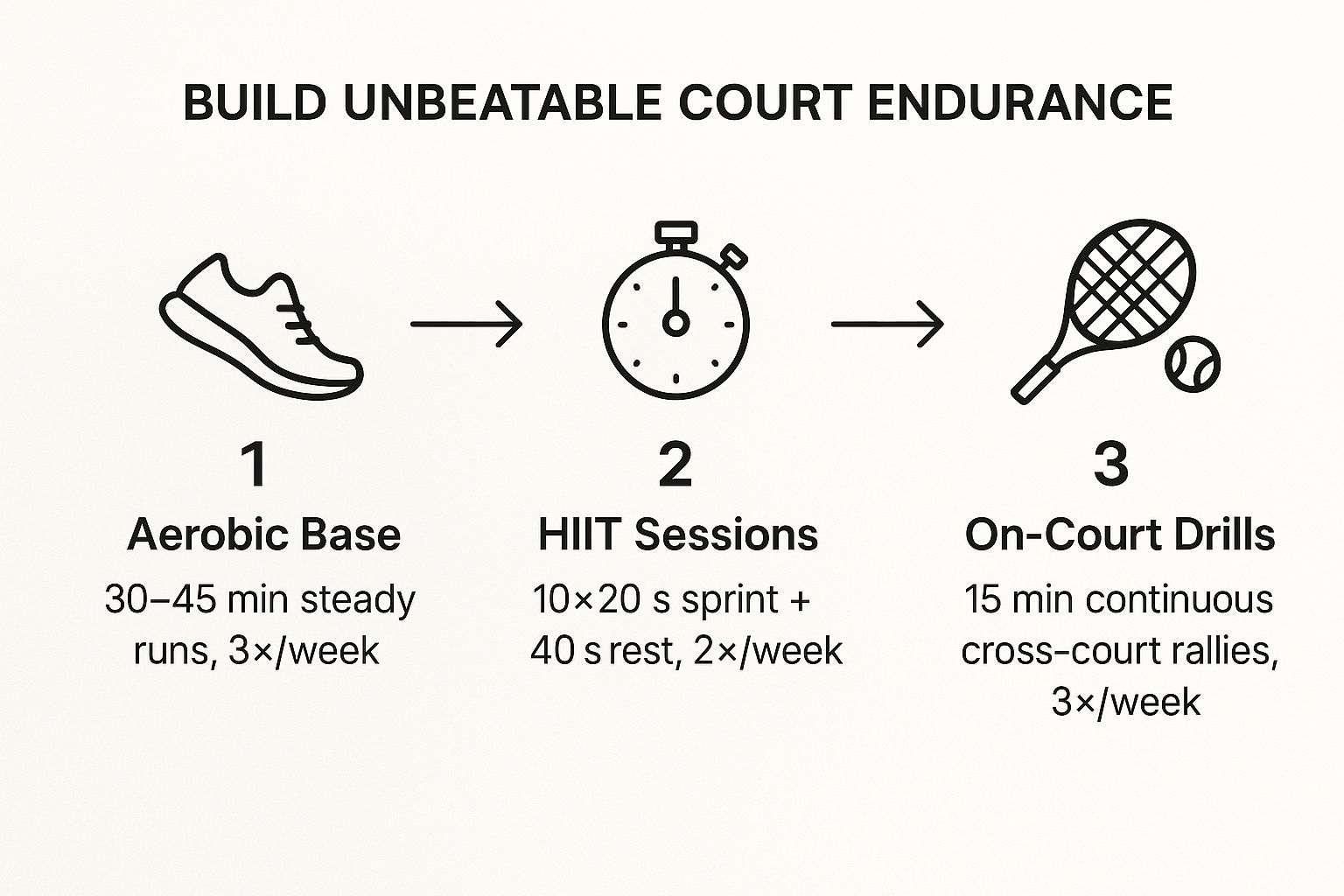
As you can see, the secret is blending a solid aerobic base with high-intensity work and practical on-court drills. That’s how you build an endurance profile that can handle anything.
Blending Training Methods for Peak Stamina
To really build that unbeatable court endurance, you need to mix up your training. Just doing steady-state cardio or only HIIT workouts won't cut it. The unique demands of tennis require a bit of everything.
- Steady-State Cardio: This is your foundation. Think jogging, cycling, or swimming for 30-45 minutes at a steady, moderate pace. It makes your heart more efficient and builds that deep well of stamina you can draw from in the third set.
- High-Intensity Interval Training (HIIT): HIIT is brilliant because it perfectly mimics the stop-start rhythm of a tennis match. A classic session could be sprinting flat-out for 20 seconds, followed by 40 seconds of rest, and repeating that cycle 8-10 times. This trains your body to recover in a flash after an intense effort.
A well-conditioned player doesn't just run faster; they recover faster. Building your endurance means you can start the twentieth point of a game with the same intensity as the first.
Taking Endurance Training On-Court
Off-court work is crucial, but let's be honest—nothing builds tennis-specific stamina quite like being on the court. The trick is to weave fitness drills into your practice sessions so they feel like a natural part of playing.
A fantastic drill for this is the continuous cross-court rally. Find a partner and just focus on keeping a rally going from corner to corner for as long as possible, maybe 15-20 minutes. You're not trying to hit winners; you're focusing on consistency and movement. It’s a killer workout that builds endurance while grooving your groundstrokes when you’re tired.
This kind of sustained activity is exactly why tennis is such a popular way to stay fit. In fact, Sport England found that around 861,000 people in England played tennis at least twice a month, showing just how many people rely on it as their go-to fitness habit.
When you apply these principles, you can be sure that every sprint and every drill is directly boosting your staying power on the court.
Putting It All Together: Your Weekly Tennis Fitness Plan
Alright, so you’ve got the exercises down. You know the drills for strength, agility, and endurance. But how do you actually piece it all together into a weekly schedule that works? This is where the real magic happens.
At Mantis, we've seen countless players hit a plateau simply because their training lacks structure. A well-thought-out plan isn't just about working hard; it's about working smart. It ensures you’re building your tennis fitness across the board—power, speed, stamina—while giving your body the recovery time it desperately needs to avoid burnout. It’s all about blending what you do on the court with dedicated work off it.
Before any intense session, a solid warm-up is non-negotiable. If you need some ideas, we've broken down our favourite tennis warm-up exercises to get your body primed and ready for action.
Building a Balanced Training Week
Think of the following schedule as a blueprint, not a rigid set of rules. It’s designed for a competitive player who wants to be sharp for a weekend match. You’ll notice how we've deliberately placed high-intensity days before lighter sessions. This isn't a coincidence; it’s a strategy to help your body adapt, repair, and come back stronger.
The most important advice we can give? Listen to your body. Some days you'll feel ready to push the limits, and other days, you'll know that an extra rest day is the smarter choice.
A great fitness plan isn't set in stone. The best athletes we've worked with are masters of adaptation. They know when to go all-out, but more importantly, they know when to pull back and prioritise recovery to stay injury-free and perform at their peak.
Don't forget that what you do in the kitchen is just as crucial as what you do on the court. To get the most out of every session, you need to fuel your body properly. Integrating some of the best post-workout recovery foods will massively speed up muscle repair and get your energy stores topped up for whatever comes next.
Sample Weekly Tennis Fitness Schedule
Here’s a look at what a practical and balanced training week could look like. This table gives you a clear structure to make sure you're consistently hitting every pillar of tennis fitness.
| Day | Focus | Example Activities |
|---|---|---|
| Monday | Strength & Power | Off-court session: Goblet squats, medicine ball throws, overhead press, and solid core work like planks. |
| Tuesday | Agility & On-Court Practice | On-court day: Start with a dynamic warm-up, then hit the agility ladder and T-drills. Follow up with hitting practice that really focuses on explosive footwork. |
| Wednesday | Endurance & Light Hitting | Off-court: A steady 30-40 minute run or cycle. On-court: Just some light rallying to maintain your feel for the ball. No intense points today. |
| Thursday | HIIT & Match Simulation | On-court: Fire up with short, intense drills like the spider drill. Then, play some practice sets to get into that competitive match mindset. |
| Friday | Active Recovery / Pre-Match Prep | Keep it light. A 20-minute walk or some gentle stretching is perfect. The main focus is on hydration and nutrition. |
| Saturday | Match Day | Perform your pre-match dynamic warm-up, give it your all in the match, and always finish with a proper cool-down and stretching session. |
| Sunday | Rest & Recovery | Full rest day. This is your time to let the body repair. Think mobility work, foam rolling, and eating well to rebuild. |
This schedule provides a fantastic foundation for building elite-level tennis fitness. Feel free to tweak the intensity and volume based on where you're at, your tournament calendar, and what you’re trying to achieve. Make it your own.
At Mantis, we’re committed to equipping players with expertly crafted gear built for performance. From our rackets to our balls, every product is designed with a purpose: to help you match your ambition on the court. See the full range at https://mantissport.com.
